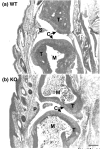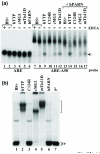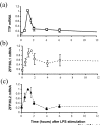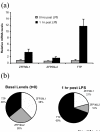The tandem CCCH zinc finger protein tristetraprolin and its relevance to cytokine mRNA turnover and arthritis
- PMID: 15535838
- PMCID: PMC1064869
- DOI: 10.1186/ar1441
The tandem CCCH zinc finger protein tristetraprolin and its relevance to cytokine mRNA turnover and arthritis
Abstract
Tristetraprolin (TTP) is the best-studied member of a small family of three proteins in humans that is characterized by a tandem CCCH zinc finger (TZF) domain with highly conserved sequences and spacing. Although initially discovered as a gene that could be induced rapidly and transiently by the stimulation of fibroblasts with growth factors and mitogens, it is now known that TTP can bind to AU-rich elements in mRNA, leading to the removal of the poly(A) tail from that mRNA and increased rates of mRNA turnover. This activity was discovered after TTP-deficient mice were created and found to have a systemic inflammatory syndrome with severe polyarticular arthritis and autoimmunity, as well as medullary and extramedullary myeloid hyperplasia. The syndrome seemed to be due predominantly to excess circulating tumor necrosis factor-alpha (TNF-alpha), resulting from the increased stability of the TNF-alpha mRNA and subsequent higher rates of secretion of the cytokine. The myeloid hyperplasia might be due in part to increased stability of granulocyte-macrophage colony-stimulating factor (GM-CSF). This review highlights briefly the characteristics of the TTP-deficiency syndrome in mice and its possible genetic modifiers, as well as recent data on the characteristics of the TTP-binding site in the TNF-alpha and GM-CSF mRNAs. Recent structural data on the characteristics of the complex between RNA and one of the TTP-related proteins are reviewed, and used to model the TTP-RNA binding complex. We review the current knowledge of TTP sequence variants in humans and discuss the possible contributions of the TTP-related proteins in mouse physiology and in human monocytes. The TTP pathway of TNF-alpha and GM-CSF mRNA degradation is a possible novel target for anti-TNF-alpha therapies for rheumatoid arthritis, and also for other conditions proven to respond to anti-TNF-alpha therapy.
Figures









References
-
- Lai WS, Stumpo DJ, Blackshear PJ. Rapid insulin-stimulated accumulation of an mRNA encoding a proline-rich protein. J Biol Chem. 1990;265:16556–16563. - PubMed
-
- Ma Q, Herschman HR. A corrected sequence for the predicted protein from the mitogen-inducible TIS11 primary response gene. Oncogene. 1991;6:1277–1278. - PubMed
-
- Varnum BC, Lim RW, Sukhatme VP, Herschman HR. Nucleotide sequence of a cDNA encoding TIS11, a message induced in Swiss 3T3 cells by the tumor promoter tetradecanoyl phorbol acetate. Oncogene. 1989;4:119–120. - PubMed
-
- DuBois RN, McLane MW, Ryder K, Lau LF, Nathans D. A growth factor-inducible nuclear protein with a novel cysteine/histidine repetitive sequence. J Biol Chem. 1990;265:19185–19191. - PubMed
Publication types
MeSH terms
Substances
LinkOut - more resources
Full Text Sources
Molecular Biology Databases

